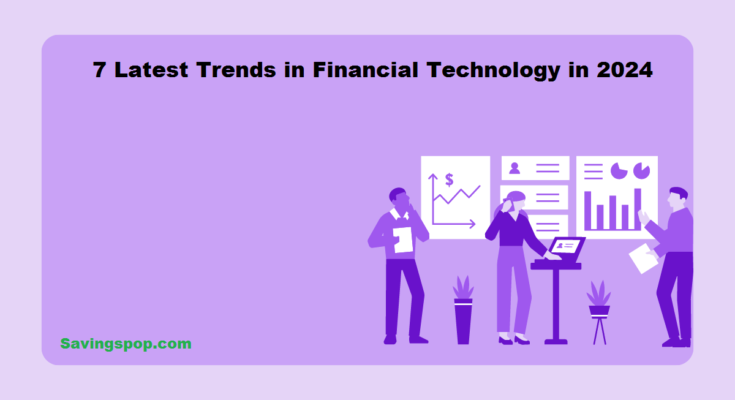Financial generation (FinTech) is poised for giant adjustments in 2024, driven by technological improvements and evolving consumer desires. This article explores 7 key trends in financial technology, offering insights into their implications for financial services globally. From the upward thrust of embedded finance and decentralized finance (DeFi) to the combination of synthetic intelligence (AI) and blockchain, those developments redefine how financial establishments function and engage with clients.
As digital payments, regulatory technologies (RegTech), and significant bank digital currencies (CBDCs) advantage prominence, the future of FinTech guarantees improved efficiency, accessibility, and innovation. Understanding these traits is important for stakeholders navigating the dynamic intersection of finance and the era within the coming years.
Introduction
FinTech is short for financial technology. It combines finance and technology. FinTech includes many innovations to improve financial services. These services help both people and businesses. As technology grows, FinTech’s role becomes more important. Everyone must keep up with the latest trends in FinTech. FinTech makes managing money easier and faster. It includes things like mobile banking, online payments, and investment apps.
By using FinTech, people can handle their finances more efficiently. Businesses can also benefit from better financial tools and services. Staying updated with FinTech trends helps in making smarter financial decisions. FinTech is changing the way we deal with money every day.
Evolution of FinTech
The history of FinTech includes many important changes. First, ATMs and online banking were introduced. These made banking easier and more convenient. Now, technologies like blockchain and artificial intelligence (AI) are used. These new tools make financial services faster and safer. They also help more people access financial services around the world. This means more people can save, invest, and borrow money. The evolution of FinTech has changed how we handle money and made financial services available to more people. Overall, FinTech has made banking simpler and more inclusive.
7 Latest Trends in Financial Technology in 2024
1. Artificial Intelligence and Machine Learning
Artificial Intelligence (AI) and Machine Learning (ML) are revolutionizing the FinTech sector by way of enabling predictive analytics, customized consumer studies, and more advantageous fraud detection. AI algorithms analyze sizeable amounts of facts to perceive styles and make data-pushed selections, remodeling how monetary institutions function and interact with clients.
Applications of AI in FinTech:
- Predictive Analytics: AI and ML examine large amounts of records to locate styles. These styles help financial establishments make informed selections about marketplace trends and client behaviors. For example, they could expect inventory charges or identify which clients are in all likelihood to want a mortgage.
- Personalized Customer Experience: AI personalizes interactions between monetary establishments and clients. Using statistics approximately individual options and behaviors, AI can provide tailor-made economic merchandise and advice. This creates a more engaging and pleasing consumer reveal.
- Fraud Detection: AI enables detect fraud by way of figuring out unusual patterns in transactions. It can speedily analyze sizable quantities of transaction information to spot anomalies that might suggest a fraudulent hobby. This makes economic transactions more steady.
2. Blockchain and Cryptocurrencies
Blockchain Basics: Blockchain is a technology that records information across many computers. This makes it hard to change or hack. It’s like a digital ledger that everyone can see and trust.
Cryptocurrencies: Cryptocurrencies are digital money. Bitcoin and Ethereum are examples. They use blockchain to track transactions. This means you don’t need banks or other middlemen to send or receive money.
How Blockchain Works: When you make a transaction with cryptocurrency, it gets grouped with other transactions into a “block.” Each block links to the previous one, forming a chain. This chain is called a blockchain. Each block has its unique code, known as a hash. If someone tries to change a block, the hash changes and everyone knows. This keeps the system secure.
Beyond Cryptocurrencies:
Blockchain can do more than just handle money. Here are two big examples:
- Decentralized Finance (DeFi):
- DeFi uses blockchain to create financial services like lending and borrowing but without banks.
- You can lend your money to someone directly and earn interest, or borrow money from someone else.
- Everything happens directly between people, using code and smart contracts, without needing a middleman.
- Smart Contracts:
- These are contracts that automatically follow rules coded into them.
- For example, if you rent an apartment, a smart contract can release the keys to you only when you pay the rent.
- This makes transactions transparent and fair, reducing the need for lawyers or notaries.
Impact of Blockchain: The blockchain era is changing how we take care of money and contracts. It’s making financial offerings inexpensive and extra handy. By slicing out intermediaries, people can keep cash on fees. Plus, it provides new opportunities for folks who do not have to get admission to traditional banking. Blockchain’s potential is sizable, extending beyond finance into areas like supply chain management, voting systems, and healthcare.
3. Open Banking
Open banking tasks facilitate stable records sharing between economic institutions and 1/3-party carriers, fostering innovation and opposition. Consumers benefit from personalized monetary services, whilst companies leverage aggregated monetary statistics to offer tailor-made products and services.
Benefits of Open Banking:
How Open Banking Works
Open banking uses technology to connect banks with third-party providers. These providers can be financial tech companies, apps, or other service providers. By sharing data, they can offer better financial products tailored to each consumer’s needs.
Enhanced Customer Experience
With open banking, customers can link multiple accounts from different banks in one app. This makes it easier to manage finances. For example, budgeting apps can provide a clearer picture of spending habits. Consumers can also receive tailored advice and product recommendations, helping them save money or get better loan rates.
Innovation and Competition
Open banking encourages innovation. Developers create new financial tools that offer unique services. These innovations make banking more convenient & accessible. For example, apps might offer better ways to save, invest, or get loans. Increased competition pushes banks to improve their services.
Regulatory Frameworks Ensure Safety
Governments and regulatory bodies set rules to ensure that data sharing is safe and secure. These regulations protect consumer privacy and build trust in the system. By following these rules, banks and third-party providers can safely share data and offer better services.
4. Digital Payments and E-Wallets
Digital payments and e-wallets are becoming more popular. This trend is growing because they are convenient, secure, and work well with mobile devices. Companies like PayPal, Square, and Alipay are leading this change. They offer easy transactions and new financial services.
Mobile Wallets:
Mobile wallets are apps that store your price facts on your phone. They make it easy to pay quickly and correctly. You don’t want to hold coins or cards. You can simply use your phone to pay for things. This is very available for folks who use their telephones plenty.
Contactless Payments:
Contactless bills use NFC (Near Field Communication) generation. With NFC, you can make bills by tapping your smartphone or card on a charge terminal. This is quicker than the usage of cash or swiping a card. It’s additionally more hygienic due to the fact there’s no want to touch the terminal.
Global Payment Solutions:
Digital payment platforms can handle payments across borders. This makes it easier for businesses to sell products to people in other countries. It also helps consumers buy things from international sellers. These platforms support many currencies and languages, making global trade simpler.
Why Digital Payments Are Growing:
The growth of digital payments is driven by several factors. First, they are very convenient. You can pay for things anytime and anywhere. Second, they are secure. These systems use encryption and other technologies to protect your money and information. Third, the rise of mobile devices has made digital payments more accessible. Many people now use smartphones, so it’s easy for them to use mobile wallets and other digital payment methods.
Impact on Businesses and Consumers:
For corporations, virtual payments can lower expenses and enhance efficiency. They don’t need to address plenty of cash or address bounced exams. For consumers, virtual bills offer velocity and convenience. You pay payments, buy products, and send cash to friends with only a few taps on your smartphone.
5. RegTech (Regulatory Technology)
RegTech solutions leverage technology to simplify regulatory compliance techniques, lowering fees and enhancing performance. Automated compliance tracking and reporting equipment allow economic establishments to stick to regulatory requirements seamlessly whilst mitigating compliance risks.
How RegTech Helps with Financial Compliance
- Automated Compliance Checks:
- RegTech uses artificial intelligence (AI) to watch transactions as they happen.
- These tools quickly spot any suspicious actions and make sure everything follows the rules.
- This real-time monitoring helps prevent illegal activities like money laundering.
- Data Privacy and Security:
- RegTech uses strong encryption to keep financial data safe.
- Secure protocols protect sensitive information from cyber-attacks.
- This ensures that customer data remains confidential and secure.
- Regulatory Reporting:
- RegTech makes reporting easier and faster.
- It helps financial institutions submit required reports on time.
- This process improves transparency and ensures that businesses are accountable for their actions.
Benefits of RegTech
- Cost Reduction:
- Automating compliance tasks saves time and reduces the need for manual labor.
- This lowers the costs associated with regulatory compliance.
- Efficiency Enhancement:
- RegTech streamlines complex processes, making them quicker and more accurate.
- This boosts the overall efficiency of financial institutions.
- Risk Mitigation:
- By ensuring that all activities follow regulatory guidelines, RegTech minimizes the risk of fines and penalties.
- It also helps prevent reputational damage from compliance failures.
In summary, RegTech is a powerful tool for economic establishments. It simplifies regulatory compliance, complements security, and improves efficiency, all even as reducing costs. By automating key strategies, RegTech helps businesses stay on top of their regulatory obligations and function more easily.
Must Read: What Do You Mean By Financial Markets?
6. InsurTech (Insurance Technology)
InsurTech improvements enhance efficiency in insurance methods, from underwriting and claims processing to customer support. AI algorithms investigate chance profiles, IoT gadgets monitor insured property in real-time, and virtual structures streamline coverage management, transforming the coverage industry landscape.
Transformative Impact of InsurTech:
Data-Driven Underwriting: Personalizing Insurance Coverage
One of the core benefits of InsurTech is its ability to leverage massive information analytics. By reading tremendous quantities of facts, InsurTech businesses can correctly investigate danger profiles. This permits them to provide personalized coverage plans tailor-made to man or woman’s wishes and risk factors. Moreover, this records-driven method facilitates competitive pricing techniques, ensuring that coverage charges replicate the unique chance profile of each purchaser.
Claims Automation: Accelerating Settlements with AI
InsurTech employs artificial intelligence (AI) to automate the processing of insurance claims. AI algorithms can manage claims efficiently and accurately, extensively reducing the time taken to settle claims. This automation not only improves operational efficiency for insurers but additionally complements client pleasure by expediting the claims process.
Enhancing Customer Engagement: Digital Platforms and Real-Time Interaction
Digital platforms play a crucial function in enhancing purchaser engagement in the coverage enterprise. InsurTech solutions provide customers with handy self-provider options, personalized pointers, and real-time updates on their coverage regulations. These structures empower customers to control their coverage needs correctly, fostering a more interactive and responsive relationship between insurers and policyholders.
The Transformative Impact of InsurTech: Shaping the Future of Insurance
InsurTech represents a transformative pressure inside the coverage enterprise, reshaping conventional practices and paving the manner for destiny innovations. By harnessing the strength of AI, big data analytics, and virtual structures, InsurTech no longer improves operational efficiency but also drives client-centric techniques to coverage offerings. This evolution towards digitalization guarantees that insurers can meet the evolving expectations of clients in a rapidly changing technological panorama.
7. Cybersecurity in FinTech
As digital adoption expands, cybersecurity remains an essential challenge for FinTech businesses and customers. Robust cybersecurity measures, such as encryption, multi-component authentication, and real-time danger tracking, are important to safeguarding touchy economic data and retaining belief in virtual financial offerings.
Key Cybersecurity Measures
FinTech companies employ several essential cybersecurity measures to protect financial data:
- Encryption: Data encryption encodes sensitive statistics, making sure the most effective legal events can get the right of entry to and be interpreted.
- Multi-thing Authentication (MFA): MFA adds an extra layer of security by requiring users to verify their identification via a couple of methods, along with passwords, biometrics, or one-time codes.
- Real-time Threat Monitoring: Continuous tracking of networks and systems detects and responds to ability cyber threats directly, minimizing the effect of attacks.
Strategies for Cybersecurity in FinTech
To effectively manage cybersecurity risks, FinTech firms implement the following strategies:
- Advanced Threat Detection: AI-driven cybersecurity tools analyze data patterns to identify and preemptively mitigate evolving cyber threats. This proactive approach boosts the overall defense mechanisms.
- Compliance with Regulatory Standards: Adherence to stringent data protection regulations such as GDPR (General Data Protection Regulation) and CCPA (California Consumer Privacy Act) ensures that customer data is handled securely and legally. Compliance also mitigates potential legal risks.
- Cybersecurity Awareness Programs: Continuous training and education programs are essential to promote cybersecurity best practices among employees and customers. By fostering a culture of awareness and vigilance, FinTech companies enhance overall resilience against cyber threats.
Emerging Markets and FinTech
Emerging markets present fertile ground for FinTech innovation, driven by mobile penetration, digital literacy initiatives, and regulatory reforms. Mobile banking solutions, microfinance platforms, and blockchain-based remittance services empower underserved populations, promoting financial inclusion and economic growth.
Opportunities in Emerging Markets:
- Mobile Financial Services: Mobile-based banking and payment solutions bridge gaps in traditional banking infrastructure, offering financial services to remote communities.
- Microfinance Initiatives: FinTech platforms facilitate micro-loans and savings programs, empowering small businesses and individuals to access capital and build financial resilience.
- Regulatory Support: Governments implement policies to promote FinTech innovation and consumer protection, fostering a conducive environment for FinTech startups and investors.
Challenges in Emerging Markets:
- Infrastructure Limitations: Limited internet connectivity and technological infrastructure hinder the widespread adoption of digital financial services in rural areas.
- Financial Literacy: Low levels of financial literacy and awareness pose barriers to accessing and utilizing FinTech solutions effectively.
- Regulatory Uncertainty: Inconsistent regulatory frameworks and compliance requirements create challenges for FinTech expansion and investment in emerging markets.
Future Outlook and Predictions
The future of FinTech holds promise for continued innovation and disruption across the global financial landscape. As technological advancements accelerate, FinTech will play a pivotal role in shaping the future of finance, driving economic growth, and enhancing financial well-being worldwide.
Expert Insights and Predictions:
- Integration of AI and Blockchain: The convergence of AI and blockchain technology will unlock new possibilities in automatic finance, decentralized applications (DApps), and quantum computing.
- Expansion of FinTech Ecosystems: Collaborations between traditional financial establishments, tech giants, and FinTech startups will enlarge FinTech ecosystems, presenting integrated answers and customized economic offerings.
- Regulatory Evolution: Regulatory bodies will adapt to technological improvements, hanging a balance between fostering innovation and making sure of client safety and information privacy.
- Impact on Global Economy: FinTech innovation will democratize get right of entry to to economic offerings, sell monetary inclusion, and stimulate monetary increase in underserved regions.
Conclusion
FinTech is at the forefront of transforming the monetary enterprise through innovation, era integration, and patron-centric solutions. By embracing these trends in financial technology, stakeholders can harness the energy of FinTech to create a more inclusive, green, and resilient worldwide economic environment. As we navigate the evolving landscape of FinTech, staying informed and adaptable can be crucial to seizing opportunities and addressing demanding situations within the pursuit of monetary empowerment and prosperity.




